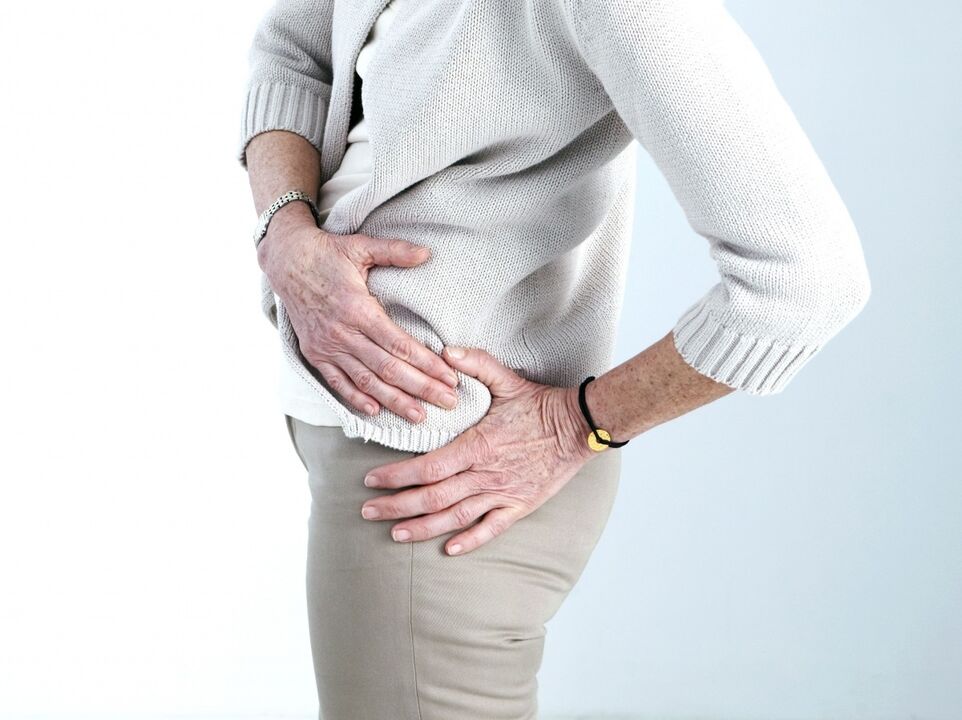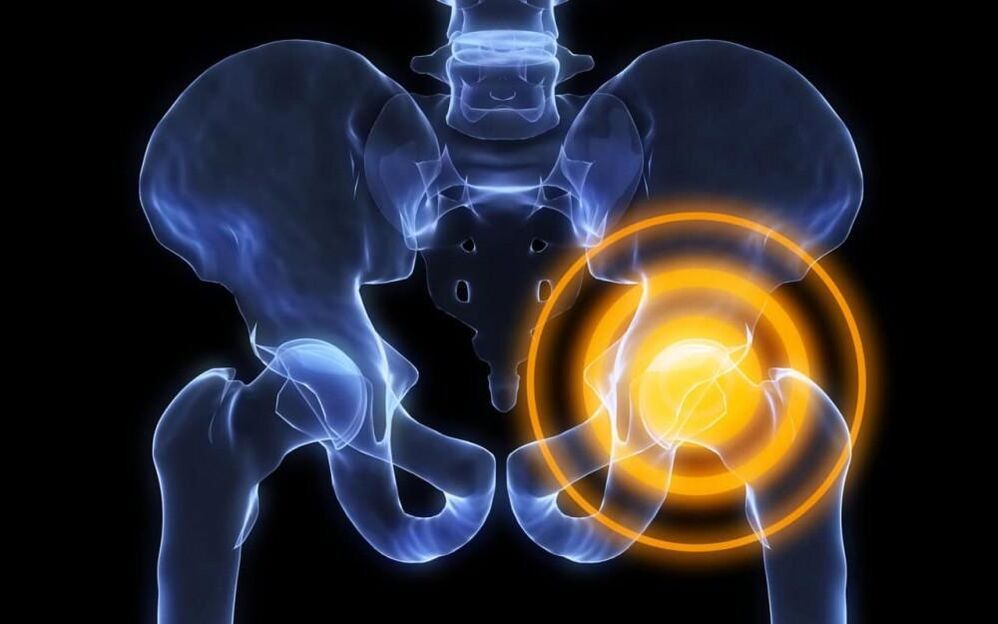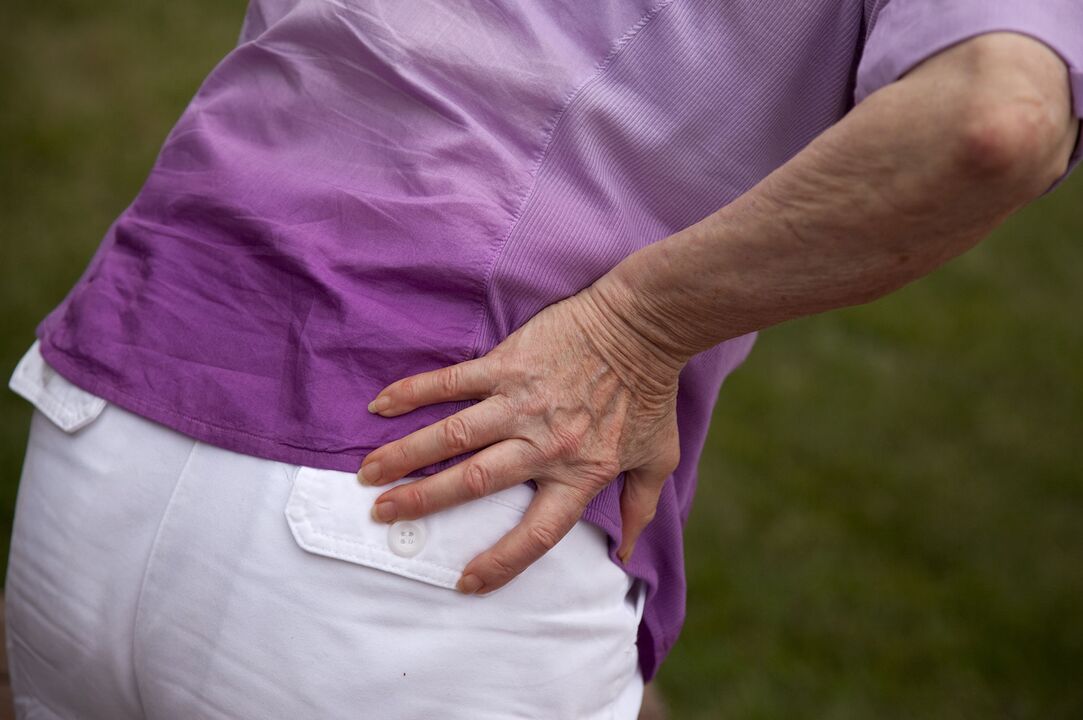
Occurrence of pain in the hip joint should definitely warn you, because this is the largest bone connection without walking is impossible. It maintains balance and redistributes body weight between the spine and lower extremities. When hip function is impaired, the patient's quality of life immediately decreases, and physical activity also decreases.
If you feel pain in your hip joint, you need to determine the cause. Treatment of pain depends on the pathology of which it is a symptom. Complex measures and strict observance of the recommendations will help to cure the disease and maintain the motor activity of the joints.
Hip joint disorder makes you unable to actively move. Functional impairment limits the patient's ability to move and function independently.
So what is the cause of such uncomfortable pain in the hip joint and how to treat it at home? Try to find out.
Reason
Pain in the hip joint can appear for various reasons: due to damage to the joint itself, both on the right and left sides, as well as the bones, cartilage or ligaments located next to it. Numbness and limitation of total hip mobility are often accompanied by pain.
Diseases of the hip joint can appear at any age, but are most common in the elderly. If pain occurs, you should see a GP, who will prescribe an initial examination and recommend which doctor you should see.
The most common causes of hip pain are:
- dislocation;
- fracture;
- inflammation, or arthritis;
- degenerative changes, or osteoarthritis (coxarthrosis);
- aseptic necrosis of the femoral head;
- inflammation of the peristaltic sac (bursitis);
- noninfectious inflammation in autoimmune diseases of the connective tissue;
- Pregnancy period.
The prevalence of pain syndrome in this localization increases with age. If in young people under the age of 18, hip pain accounts for 8-10%, for middle-aged people this figure is 20-30%. At the age of 50-59, 40% have suffered from this condition, and in older people - from 50 to 60%. Women are more likely to have focal pain syndrome than men.
By age
Typical medical conditions for different age groups that cause hip pain:
- Adults and Seniors. Osteoarthritis (coxarthrosis), injury and deformity of the joint, pressing on the joint.
- Children and adolescents. Perthes disease, transient bursitis, acquired varus malformation, tuberculous lesions, trauma and joint deformity.
- Infants and infants under 1 year of age. Congenital hip dislocation, consequence of general arrhythmia, acute purulent osteoarthritis, congenital varus malformation.
Bursitis
The main signs of bursitis:
- with the development of the disease, the appearance of back pain;
- increased discomfort when moving the leg;
- pain increases after sitting for a long time, back pain;
- Sharp pain and burning, especially when lying on the side at night, extends over the entire surface of the thigh.
If infected, purulent bursitis may appear, presenting as acute pain in the hip joint. For this type of bursitis, a characteristic symptom is the inability to fully extend the leg. When pressed, there is a hard feeling, which can spread over the large surface of the thigh. Perhaps the appearance of back pain.
Osteoarthritis (coxarthrosis)
Coxarthrosis is based on degenerative (destructive) and dystrophic (malnutrition) processes in the hip joint. As a result, the joint no longer performs its functions - the movements of the legs are interrupted. It can be an independent disease or develop with secondary damage to the joint (tumour in the bone). In old age, coxarthrosis develops again after a hip fracture.
Depending on the severity of the changes that have occurred in the joint, there are 3 stages of coxarthrosis.
- In stage 3, pain in the hip joint bothers the patient even at rest, at night. Sign of lameness, forced to use cane.
- In stage 2 of coxarthrosis, the pain begins to radiate down the groin, the inner side, and the front of the thigh, often down to the knee. They appear after normal daily load, but at rest they don't bother.
- Stage 1 is characterized by pain in the hip joint that occurs with excessive exertion: walking up stairs with a load on your hands, walking more than 2-3 km, running. The pain subsides after a short period of rest.
The choice of treatment for osteoarthritis of the hip depends on the severity of the changes that have occurred in the joint. As a rule, grades 1 and 2 of the disease can be treated conservatively. Anti-inflammatory drugs, chondroprotectors, drugs that improve blood circulation in the joints, physiotherapy and therapeutic exercises are prescribed. The final stage is treated only with the help of operations.

Hip fracture
A very common injury, especially in older people with weak bones. This condition is characterized by severe pain, the inability to perform any movement in the joint.
In this case, hospitalization is required for proper treatment, as hip fractures are often complicated by an infectious process, such as bacterial arthritis, etc. v. The extra inflammation greatly impairs fracture healing and contributes to improper bone fusion.
Hip dislocation
Usually it is the result of road accidents, and also occurs with falls and various occupational injuries.
Clinical manifestations in dislocation: acute unbearable pain, almost absolute difficulty in lower limb movement, damage to nerve endings, loss of sensitivity of the foot and ankle joints. With bilateral dislocation, symptoms are presented as an incoherent cry, or "duck gait".
It is worth highlighting such a concept as congenital hip dislocation, which is diagnosed in neonates. This disease is a consequence of underdevelopment of the femur, as a result of which the head of the femur falls out of its bounds, thereby forming a dislocation.
Subluxation
This is incomplete contact between the femoral head and the femoral head. People do not feel pain, movement is slightly limited, but discomfort constantly appears.
Rheumatism
A systemic disease of the connective tissue, accompanied by damage to the joints and heart valve apparatus. It develops more often in girls and young women after strep throat.
About two weeks after the onset of the disease, severe pain appeared in the large joints, gradually decreased and disappeared. Rheumatoid arthritis does not cause permanent damage to the joints, its main danger is the development of acquired heart defects.
Arthritis
Arthritis is especially common in the elderly. The older you get, the more processes happen inside the joint. Discomfort occurs in the legs and groin area, cramps can be felt in the front of the thigh and even up to the knee. Symptoms are worse when walking and resting on the legs. It becomes difficult to get up from a sitting position, which causes severe pain in the hip joint.
Usually, the discomfort increases in the morning, but with physical activity it subsides. But with excessive load, unpleasant sensations increase and stiffness appears during movements. Treatment depends on the diagnosis, usually anti-inflammatory drugs, exercise therapy, and hormone medications are prescribed.

Infection
Infectious arthritis can be caused by viruses such as influenza, staphylococcus, streptococcus and others… In those cases, the disease develops rapidly. Fever begins, swelling is observed in the area of the affected joint. Acute pain in the hip is observed with movement and even touching the affected area.
A slightly different symptom is observed in tuberculous arthritis, which usually affects the hip joint. In this case, the disease feels itself gradually. At first, a person begins to feel uncomfortable by a slight pain when walking, which spreads down the leg - the middle part of the thigh or knee. When the disease is advanced, the hip joint is limited in all directions, and the affected area is swollen.
Tendonitis
Tendonitis, or tendinitis, commonly affects people exposed to high levels of regular physical activity. Usually these are athletes. It should be noted that the disease sometimes progresses unnoticed, especially if the patient reduces the load on the hip. And conversely, when exercising too hard and carrying heavy loads, the pain becomes very strong.
Treatment of tendonitis is carried out with anti-inflammatory drugs - non-steroidal anti-inflammatory drugs may be prescribed.
Which doctor is treating?
You may need help from these doctors if you have pain in your hip:
- Rheumatologist;
- Trauma doctor or orthopedist;
- Physiotherapist;
- Neurologist.
A specialist doctor will conduct a survey, examine the patient, and prescribe a general examination.
Diagnose
Laboratory research methods and tools:
- X-ray and ultrasound examination. They are the gold standard for most hip diseases.
- General blood analysis. It will give an opportunity to assess the general condition of the body.
- Blood biochemical tests and specific markers of rheumatic diseases.
- Urine test. Color, quantity, clarity, and consistency of urine were determined. In addition, protein, glucose and bilirubin are important indicators.
- Morphological examination of biopsy specimens. It is used to study the structure of the material taken, especially often in cases where cancer of the skeleton is suspected.
- CT scan. Allows visualization of the joint, bone tissue in several views, to determine its density.
- Magnetic resonance imaging. Visible in thin layers of body tissue in any plane.
- Bone technique. With the advent of osteopathic radiopharmaceuticals, the state of blood flow in bone tissue and the intensity of metabolism are visualized.
Note the decrease in joint mobility. Remember to see if the illness is accompanied by fever, headache, local congestion, edema, and other local manifestations. Do not be afraid to draw the attention of a specialist about possible causes of the disease. Describe in detail everything that bothers you.
How to treat hip pain?
What should I do if I find symptoms of pain in the hip area? After all, the pelvis is an important link in the musculoskeletal system. And if you have severe pain, you should immediately contact a specialist. He will help diagnose and determine the cause of the problem. The earlier the diagnosis, the more effective the treatment.
If you suspect that mild pain is related to a minor injury or joint overload, you can take the following measures:
- Avoid stress on painful joints, keep calm;
- taking non-steroidal anti-inflammatory drugs;
- During sleep, it is recommended to lie on the healthy side.
Drug therapy includes a complex dose of drugs in various directions:
- Hondoprotectors, mineral and vitamin complexes.
- Muscle relaxants help reduce spasms during pain.
- NSAIDs and steroids. Steroids are prescribed only for severe symptoms.
- Means to improve microcirculation. They reduce the manifestations of edema and hypoxia in the affected area.
- Diuretics to reduce swelling in the inflamed area.
Physiotherapy measures are also of great importance in the treatment of hip diseases. They are carried out after eliminating acute inflammation and severe pain. Electrophoresis has been proven well, with the help of drugs it is possible to produce high concentrations of drugs directly into the affected area.
One progressive method is considered laser therapy, which produces analgesic, anti-inflammatory and anti-inflammatory effects. Magnetic therapy, diode dynamics, and drug electrophoresis have also been used successfully.



























